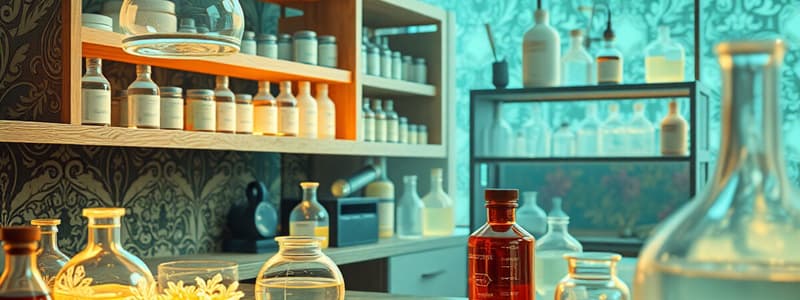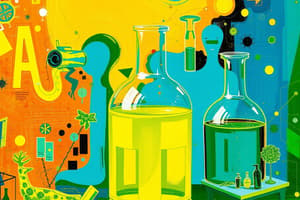Podcast
Questions and Answers
What is the primary role of glycerol in potato starch-based bioplastics?
What is the primary role of glycerol in potato starch-based bioplastics?
- To help in the breakdown of amylose into glucose units
- To serve as a plasticizer that increases flexibility (correct)
- To act as a catalyst for polymerization
- To enhance the biodegradability of the plastic
Which bacteria species are NOT mentioned as contributors to bioplastics degradation?
Which bacteria species are NOT mentioned as contributors to bioplastics degradation?
- Staphylococcus species
- Pseudomonas species
- Streptococcus species
- E. coli (correct)
What characteristic of amylos is primarily responsible for its brittleness in bioplastics?
What characteristic of amylos is primarily responsible for its brittleness in bioplastics?
- It is highly branched
- It has long-chain polymer structures (correct)
- It easily polymerizes with other molecules
- It absorbs water effectively
How does adding glycerol enhance the performance of potato starch-based bioplastics?
How does adding glycerol enhance the performance of potato starch-based bioplastics?
What is the function of HCl in the preparation of potato starch-based bioplastics?
What is the function of HCl in the preparation of potato starch-based bioplastics?
What components make up potato starch?
What components make up potato starch?
Which of the following factors does NOT contribute to the biodegradation of bioplastics?
Which of the following factors does NOT contribute to the biodegradation of bioplastics?
What type of plastics break down when exposed to sunlight?
What type of plastics break down when exposed to sunlight?
What is the main reason that water aids in the biodegradation of plastics?
What is the main reason that water aids in the biodegradation of plastics?
What added benefit does glycerol provide to starch-based bioplastics other than flexibility?
What added benefit does glycerol provide to starch-based bioplastics other than flexibility?
What is a primary benefit of bioplastics compared to traditional plastics?
What is a primary benefit of bioplastics compared to traditional plastics?
Which type of bioplastic is widely used for creating drug capsules?
Which type of bioplastic is widely used for creating drug capsules?
What is a characteristic feature of cellulose-based bioplastics?
What is a characteristic feature of cellulose-based bioplastics?
Which of the following statements about traditional plastics is true?
Which of the following statements about traditional plastics is true?
What are starch-based bioplastics primarily made from?
What are starch-based bioplastics primarily made from?
What is one important learning objective for students in the preparation of biodegradable plastics?
What is one important learning objective for students in the preparation of biodegradable plastics?
Which of the following is NOT a use for protein-based bioplastics?
Which of the following is NOT a use for protein-based bioplastics?
Which of the following materials is commonly utilized for wrapping goods in bioplastics?
Which of the following materials is commonly utilized for wrapping goods in bioplastics?
What is a significant environmental concern associated with traditional plastics?
What is a significant environmental concern associated with traditional plastics?
Which of the following is a characteristic of renewable sources used for bioplastics?
Which of the following is a characteristic of renewable sources used for bioplastics?
Flashcards
Bioplastics
Bioplastics
Plastics derived from renewable biomass sources like vegetable oil or corn starch.
Starch-based bioplastics
Starch-based bioplastics
Bioplastics made from natural starch.
Cellulose-based bioplastics
Cellulose-based bioplastics
Bioplastics made from cellulose esters.
Protein-based bioplastics
Protein-based bioplastics
Signup and view all the flashcards
Traditional plastics
Traditional plastics
Signup and view all the flashcards
Biodegradable plastics
Biodegradable plastics
Signup and view all the flashcards
Plastic film from potato starch
Plastic film from potato starch
Signup and view all the flashcards
Global Warming
Global Warming
Signup and view all the flashcards
Learning Objective
Learning Objective
Signup and view all the flashcards
Biodegradation
Biodegradation
Signup and view all the flashcards
Biodegradable Plastics
Biodegradable Plastics
Signup and view all the flashcards
Photodegradable Plastics
Photodegradable Plastics
Signup and view all the flashcards
Potato Starch
Potato Starch
Signup and view all the flashcards
Amylose
Amylose
Signup and view all the flashcards
Amylopectin
Amylopectin
Signup and view all the flashcards
Purpose of HCl in Starch-Based Bioplastic
Purpose of HCl in Starch-Based Bioplastic
Signup and view all the flashcards
Purpose of Glycerol in Starch-Based Bioplastic
Purpose of Glycerol in Starch-Based Bioplastic
Signup and view all the flashcards
How Glycerol Plasticizes Bioplastic
How Glycerol Plasticizes Bioplastic
Signup and view all the flashcards
Bacteria in Bioplastic Degradation
Bacteria in Bioplastic Degradation
Signup and view all the flashcards
Study Notes
Prayer Before Class
- Holy Spirit is the true source of light and wisdom
- Prayer requests a penetrating mind for understanding
- Prayer requests a retentive memory for easy learning
- Prayer requests clarity and ease of expression
- Prayer requests guidance and success in the work
- Prayer is made through Jesus Christ, the Father, and seeks eternal reign
Post-Laboratory Discussion: Preparation of Biodegradable Plastics
- The discussion is about biodegradable plastics, specifically, the preparation of them.
- It's part of a Chemistry for Engineers Laboratory.
Learning Objective
- Students are expected to create a plastic film from potato starch.
PLASTICS
- Plastics are derived from petroleum oil.
- Plastics rely heavily on scarce fossil fuels.
- Burning plastics releases carbon dioxide which contributes to global warming.
- Plastics take a long time to decompose.
Decomposition Times of Materials
- Batteries: 110 years
- Vegetables (leaves, branches): 1-6 months
- Food waste: 1 month
- Newspapers: > 1 month
- Office papers: ~2 years
- Wax paper: up to 5 years
- Stub filter: 2-3 years
- Chewing gum: 30 years
- Natural fabrics clothes: 2-3 years
- Synthetic clothes: up to 40 years
- Shoes (natural): 10 years, (synthetic): 80 years
- Iron cans: 10 years
- Tin cans: 90 years
- Aluminum cans : 500 years
- Polyethylene bags and plastic bottles: 100-200 years
- Baby diapers: 200-500 years
- Rubber tires: 120-140 years
- Glass: 1000 years
What are BIOPLASTICS?
- Bioplastics are plastics derived from renewable biomass sources, such as vegetable oil or corn starch.
Types of Bioplastics
- Starch-based: made from natural starch; used for packaging and drug capsules.
- Cellulose-based: made of cellulose esters; used in thermoplastics and packaging.
- Protein-based: made from proteins (soy, wheat); used for body panels in automobiles.
- Some aliphatic polyesters
Characteristics of Petroleum-based and Bioplastics
- Energy consumption: Bioplastics use 48% less energy than petroleum-based plastics.
- Raw Materials: Petroleum-based plastics use petroleum, a non-renewable resource. Bioplastics use renewable biomass sources (starch, corn, sugarcane, potato).
- Carbon Footprint: Petroleum-based plastics have a high carbon footprint. Bioplastics have a 62% lower carbon footprint than traditional plastics.
- Presence of chemicals: Petroleum-based plastics may contain Bisphenol A (BPA). Bioplastics do not contain any toxic chemicals.
- Physical properties: Both types are stable, although Bioplastics have high thermo-plasticity.
- Biodegradability: Bioplastics can decompose in natural settings in ~180 days. Petroleum-based plastics take > 1000 years to decompose completely.
Biodegradability
- Biodegradation is the breakdown of organic materials by natural processes and microorganisms.
- Factors that contribute: sunlight, water, bacteria, enzymes, wind abrasion.
Biodegradation of Bioplastics
- Biodegradation can be facilitated by bacteria in soil, such as Pseudomonas and Streptococcus species.
- Addition of glycerol to potato starch based bioplastics increases the degradation of the bioplastic as it helps the material absorb water.
- Water is a medium for most bacteria and microbes.
Degradable Plastics Types
- Biodegradable: contain a small percentage of non-oil-based materials like corn starch.
- Photodegradable: break down when exposed to sunlight.
Potato Starch
- Potato starch is a polymer made of glucose units.
- It contains two carbohydrate polymers: amylose (long-chain) and amylopectin (highly-branched), with amylopectin making up the majority.
Potato Starch Based Bioplastic
- HCl breaks down amylopectin to enable film formation.
- Glycerol acts as a plasticizer, increasing the flexibility and elasticity of the bioplastic.
- Glycerol disrupts hydrogen bonds in the starch, weakening the structure and enabling further plasticity.
- Glycerol increases the bioplastic's ability to absorb moisture further increasing its flexibility.
End of discussion
Studying That Suits You
Use AI to generate personalized quizzes and flashcards to suit your learning preferences.




